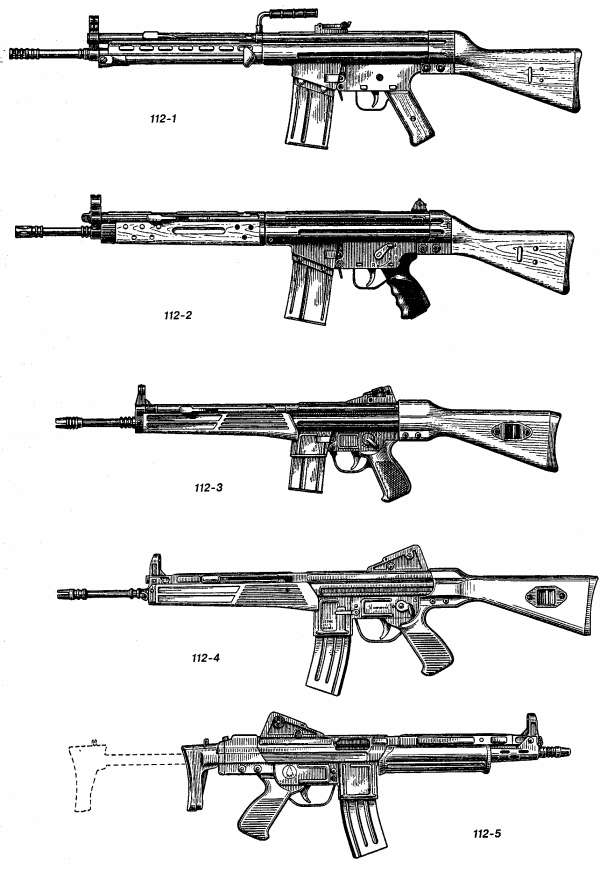From SAM 96, translation by the Stoat:
German military weapons: the MG45 (MG42V)
As is known, during the Second World War the German army made use of a large number of different machine guns. At the start of the war these were principally the various variants of the German Maxim (the "Spandau"M08 and M08/15), the MG 34, and captured weapons such as the Czech ZB 26, 27 and 30. Even though the MG 34 had many special qualities, the weapon performed less well in practice that was foreseen. Shortly after the adoption of the weapon, the development of a new weapon had already begun.
The result was the well-known MG 42, which was taken into use from the end of 1942 on a still greater scale. The MG 42 offered a number of advantages in view of its predecessor. The weapon could be made cheaper and faster, and was much less sensitive to fouling. The extremely high rate of fire and the accompanying characteristic sound of ripping material above all inspired much respect in the opponent.
Yet the German army leadership was also not completely satisfied with his weapon. Consequently it was already decided, around the end of 1943 or the start of 1944, to develop a new machine gun. In principle, this machine gun should have been able to deliver the same performance as the MG 42, but had to be able to be produced even cheaper: without special machines and the use of special materials. In addition it should have been lighter than the MG 42, and should have been able to function without lubrication.
MG 45 or MG 42V
The newly developed weapon was to be known by two different appellations: the MG 45 at the MG 42V. The first name presumably stood for the deadline by which it should have been taken into use, but trustworthy information about this is missing. There is also unclarity about the second appellation. The letter “V” could stand just as well for “Versuch” (experimental) as for “Verbessert” (improved). From the accompanying pictures it seems in any case that the test weapon was a (radically) altered MG 42.
The MG 45, as we shall call the weapon hereafter, derives its whole styling and a large number of components from the MG 42. Above all the stock, receiver, pistol grip, barrel jacket and bipod of the MG 45 strongly resemble – although more roughly finished – those of its illustrious predecessor. At that point the similarity ends, however, since when the construction and the mechanism are inspected more closely, important differences are found.
Differences from the MG 42
In contrast with the MG 42, the MG 45 was a weapon with mass-retarded roller locking. Whilst the roller mechanism of the MG 42 genuinely mechanically locked the breech block during the shot, the roller mechanism of the MG 45 only leads to a delayed opening. (Technical enthusiasts can re-read about the difference in SAM 82). The same system was later applied to, amongst others, the Cetme, H&K rifles and machineguns, the Swiss MG710-1 and the MG 60-01 and 60-02 from Rheinmetall.
The MG 45 had a fixed barrel with a “locking collar”, into which the rollers of the breech block fall. Due to the internal shape of the collar the rollers are moved at such an angle that they don’t fully lock the breech block, but only slow down the rearward movement. The MG 45 was thus a (inertia) delayed , with a completely different breech block to the roller-locked MG 42. Lastly, the MG 45 was much more roughly finished and could not be dismantled as far as the MG 42, because a large number of components were riveted or welded together.
In practice
According to the scarce data, tests were held successfully with a number of weapons. One MG 45 even shot 120,000 rounds in succession with a rate of fire of 1350 rounds per minute without a single malfunction. Yet the project ended, probably in the autumn of 1944, without more than about 10 test weapon is being made.
We can only speculate about the how and why of this inglorious end, since there is not more reliable data available that the illustrations here and some scarce information. It seems probable that it was judged that the improvements were not equal to the necessary investment of yet another whole new production line, but one cannot say for certain.
For comparison, MG 42 left side:

Barrel, two-piece breech block, cocking handle and return spring disassembled. Note the collar on the back end of the barrel:

MG 42 stripped: note the large differences (unless you are Tinwalt, in which case this will look almost identical to the other one):

The heart of the MG 45: the rear end of the barrel with the collar and the two-piece breech block. On this original drawing (from December 1944), the inertia lock is aptly called ‘quasiverschluss’ (quasi-lock):



